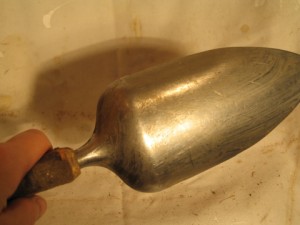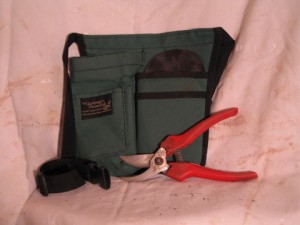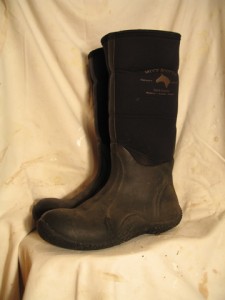Give the Gift of Garden Gear
December is a gift-giving time of year for many people. In light of the upcoming (okay—already upon us!) holiday season, I thought you might find it helpful to know what sorts of tools and implements impress a professional gardener. Gardener gift lists abound, but they aren’t always compiled by people who garden a lot! I garden for a living, and I consider all the items below to be indispensable in my business. They’ve served me well, so I can vouch for their ability to last a long time and give you good value for your money. And if you’ve already finished your holiday shopping, well, file these away as gift ideas for upcoming birthdays and other occasions when you want to give a gardener a gift.
A warning to those of you accustomed to marketing shots of pristine garden products: you’ll find no fancy-pants photos here. These are my actual garden tools in their actual current state, at the end of a long gardening year and before their annual winter cleaning. They’re dirty, and yes, that’s a dropcloth as a backdrop. Use the links provided to see how these products will look “out of the box.”
Full disclosure: I promise that I am neither being paid to recommend any of these products, nor have I received free products, advertising or any other perks to “endorse” them …although I’d like to get all of those!

If this Cutco trowel were a person, it would be going on 29…again. It’s dirty, but it’s not rusted or bent.
Cutco trowel
Like so many hand tools, the usual problem with trowels is that they’re not strong enough. At the top of the blade where it thins to mate with the handle, a cheap trowel will bend if you try to dig in less-than-ideal soil. My Cutco has never bent and doesn’t have so much as a hint of rust after seasons of use. That’s never happened before, and I’ll never use any other trowel. As a welcome added feature, it’s also got a comfortable grip. You can see it at Cutco.com. Follow instructions at the website to order directly from the manufacturer. At $42, the price seems high for a trowel, but if that trowel lasts as long as half a dozen other ones (and I think mine will), it seems like a great bargain to me.
Atlas gloves
A glove’s a glove’s a glove, right? Wrong. There are big differences between garden gloves. Nitrile gloves are my favorite because they’re thin enough to allow decent dexterity, yet they provide all the protection your hands should need for ordinary jobs. Atlas nitrile gloves have an extra long cuff that can be tucked inside or over your sleeve ends so you don’t get that “bracelet” of dirt around your wrist after a few hours of work. They come in bright colors that won’t disappear into the vegetation if you take them off for a moment in the garden and absent-mindedly walk away. (I recommend blue, pink and purple for their visibility.) They will not shrink when machine washed and dried, and each pair lasts for months even with constant use. You can view and order these gloves at a great price (2 pair for $6) from Gardener’s Supply, but many hardware stores also stock them, so check your local retailers.

My favorite Felco F300 pruners and Napa Valley Gardener’s Phone Pak, a little worse for wear.
Felco F300 bypass pruners
Felco pruners are legendary…but for many years I couldn’t understand why! Yes, they seemed to be good quality, but none of them fit my hand—they all seemed to be sized for a 6-foot tall lumberjack—so they were tiring to use and expensive to boot. Finally, about two years ago, I found the Felcos for me. The F300 is so lightweight it’s usually referred to as a “snip,” but it’s perfectly adequate for all-purpose light-duty pruning of non-woody material. If you’re deadheading a perennial garden, these are perfect! Aside from being comfortable in my hand, they’re easy to lock and unlock one-handed (a very important pruner feature often overlooked), they slip easily into my favorite pruner holster (see below), and their red handle makes them stand out when I misplace them. Here’s a tip: when the spring broke on my pair (to be expected after a lot of use), I was able to find a suitable and inexpensive replacement in the hardware bins at a local hardware store. You can see and order this pruner for under $20 at Felco’s online store.
The Napa Valley Gardener pruner holster
I wear this pruner holster so much it’s practically a wardrobe staple. (Isn’t that embarrassing?) It’s small and comfortable with an adjustable belt, but it holds a pruner in a plastic-lined pocket, has a phone receptacle large enough to accommodate an “old-fashioned” full-size handset (not just a slimline modern cell phone), and it also has a key clip. Although it has plastic parts, I have machine washed and dried my holster many times, and it has worn very, very well. The full name for this item is actually the Gardener’s Phone Pak. You can view and buy it at Napa Valley Gardener’s website for under $20.
With my Muck boots on, it doesn’t matter how wet the ground is.
Muck Boot boots
Like the pruner holster above, I wear my Muck boots practically every day, and I’ve had them so long I can barely remember buying them. I own the Tack Classic Hi style, which runs about $100 but can probably be found for less with holiday discounts. With these on, you could wade through standing water for hours and your feet would never, ever get wet. They’re great in the garden, but I also use them all winter long while shoveling or blowing snow. There are many Muck Boot styles for different activities, including heavily insulated ones for winter, so look through them all before deciding which one seems right for you. You can also buy replacement insoles—a thoughtful accommodation. You can see all the choices and make a purchase at the Muck Boot website, but I’ve also seen them at Agway stores, and they’re probably available at other farm/feed stores and garden centers.



I love my Felco pruners too. The phone pack is a great idea. I am constantly burying my pruners and I garden in fear of loosing them beneath some pile of debris. And putting the phone, and key for my shed in there would have saved me from forgetting the phone and leaving it on my porch in the rain as well as holding my key in my teeth until they got tired and ending up holding it in my hand and throwing it into the garden with some leaves, never to be found again. Yes, somewhere in my garden is a shed key. I’m ordering one today.
How do you care for your pruners? Do you sharpen them? oil them? clean them? I’d also like any tips for raking leaves. What’s the best rake and any suggestions for making raking more efficient?
Your story made me chuckle, Alice! You can take comfort in the knowledge that you are not alone. My shed key once went missing for over a year until I found it in the bottom of a stored pot, right where I’d put it for “safekeeping”…until I stacked a dozen other pots on top of it! That’s why I have the pruner holster now.
Tool care will be the subject of future posts, but I’ll answer your questions briefly here. Yes, I sharpen them. Sometimes I have to sharpen them daily because I use them so much. (This has been true for every pruner I’ve ever owned, so it’s not just a matter of some pruners holding an edge better than others.) I’ve never found what I’d call a “great” sharpener, and I’d love to hear from other readers if they can recommend a portable sharpening device with preset standard blade angles that they think is the cat’s meow. I use a Multi-Sharp 1601 Secateur & Lopper Sharpener (a British import) that I’ve had for ages and need to replace.
Every winter at season’s end all my tools get a “spa” day. First, I wash the handles of pruners with soap and water, using an old toothbrush to remove dirt from any hard-to-reach areas. Then I clean the blades with ordinary household oil (what you’d use to oil a squeaky hinge) and emery paper to remove anything stubbornly stuck on. Then I use another old toothbrush and oil to clean the spring and anything else metallic. I sharpen them and then wipe them clean with a rag, and they’re ready to be stored for the season.
I’ll have to think more about your questions about raking, but one thing that springs to mind is that it’s good to have a number of substantially different rakes for working in different areas. A rake with a broad fan of blades is best for most work, but for getting into tight areas you’ll find it easier to use a rake with a small or adjustable fan. I also have a miniature hand rake that’s great for cleaning leaves out from under low-spreading shrubs. I’ll see if I can’t find some specific make and model information to share in a future post.
Much appreciated. I’m no Spring chicken and raking one acre of wooded property is a handful.
Great write-ups here. I’ve owned Felcos for years, but can’t say the same for gardening gloves. I don’t wear them unless I’m pruning prickly roses (roses don’t have thorns). I don’t keep my Felcos in a pouch either, but probably should. And mucks are usually not on my feet in summer as they are way too warm for me. If I can’t do it in sandals, it don’t get done (unless I’m doin some heavy diggin).
Again, good reports!
Yes, roses don’t have thorns…but they do a good impression!
Personally, I always wear gloves when working in the garden. It makes cleaning my hands at the end of the day (or before lunch) so much easier, and through the years I’ve become more conscious of the need to avoid disease pathogens and keep harsh substances away from my skin. I handle a fair number of “nasty” things, such as dried blood and manure, with great frequency, but what really drilled the need to wear gloves into my head was a bad rash I got one spring that I attributed to fungicides on 4″ annuals I’d been handling. Many fungicides can cause dermatitis. That episode was quite unpleasant!
I know what you mean about Muck boots, or any boots, getting hot when the weather warms. One great thing about my Mucks is that they’re made of a very flexible material (neoprene, I think), so I can fold them down for better ventilation on warm mornings. But even in hot weather I wear them in the AM until the dew evaporates, and after that I shed them for work shoes. Wet, clammy feet are the enemy in any season. And if I tried to garden in sandals, well, I think I’d be missing more than a few toes by now! My Tack Classic Mucks have, essentially, steel-tipped toes. They’re intended to provide protection against the feet of horses and other hooved animals, but they also prevent damage from heavy metal objects and logs dropped from a height of about three feet, if you know what I mean. Is there an emoticon for a sheepish grin? If so, insert one here!